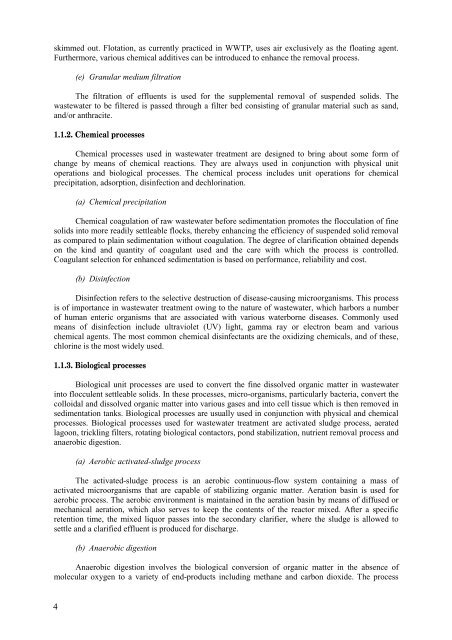Download file - Ayuntamiento de Zaragoza
Download file - Ayuntamiento de Zaragoza
Download file - Ayuntamiento de Zaragoza
You also want an ePaper? Increase the reach of your titles
YUMPU automatically turns print PDFs into web optimized ePapers that Google loves.
skimmed out. Flotation, as currently practiced in WWTP, uses air exclusively as the floating agent.Furthermore, various chemical additives can be introduced to enhance the removal process.(e) Granular medium filtrationThe filtration of effluents is used for the supplemental removal of suspen<strong>de</strong>d solids. Thewastewater to be filtered is passed through a filter bed consisting of granular material such as sand,and/or anthracite.1.1.2. Chemical processesChemical processes used in wastewater treatment are <strong>de</strong>signed to bring about some form ofchange by means of chemical reactions. They are always used in conjunction with physical unitoperations and biological processes. The chemical process inclu<strong>de</strong>s unit operations for chemicalprecipitation, adsorption, disinfection and <strong>de</strong>chlorination.(a) Chemical precipitationChemical coagulation of raw wastewater before sedimentation promotes the flocculation of finesolids into more readily settleable flocks, thereby enhancing the efficiency of suspen<strong>de</strong>d solid removalas compared to plain sedimentation without coagulation. The <strong>de</strong>gree of clarification obtained <strong>de</strong>pendson the kind and quantity of coagulant used and the care with which the process is controlled.Coagulant selection for enhanced sedimentation is based on performance, reliability and cost.(b) DisinfectionDisinfection refers to the selective <strong>de</strong>struction of disease-causing microorganisms. This processis of importance in wastewater treatment owing to the nature of wastewater, which harbors a numberof human enteric organisms that are associated with various waterborne diseases. Commonly usedmeans of disinfection inclu<strong>de</strong> ultraviolet (UV) light, gamma ray or electron beam and variouschemical agents. The most common chemical disinfectants are the oxidizing chemicals, and of these,chlorine is the most wi<strong>de</strong>ly used.1.1.3. Biological processesBiological unit processes are used to convert the fine dissolved organic matter in wastewaterinto flocculent settleable solids. In these processes, micro-organisms, particularly bacteria, convert thecolloidal and dissolved organic matter into various gases and into cell tissue which is then removed insedimentation tanks. Biological processes are usually used in conjunction with physical and chemicalprocesses. Biological processes used for wastewater treatment are activated sludge process, aeratedlagoon, trickling filters, rotating biological contactors, pond stabilization, nutrient removal process andanaerobic digestion.(a) Aerobic activated-sludge processThe activated-sludge process is an aerobic continuous-flow system containing a mass ofactivated microorganisms that are capable of stabilizing organic matter. Aeration basin is used foraerobic process. The aerobic environment is maintained in the aeration basin by means of diffused ormechanical aeration, which also serves to keep the contents of the reactor mixed. After a specificretention time, the mixed liquor passes into the secondary clarifier, where the sludge is allowed tosettle and a clarified effluent is produced for discharge.(b) Anaerobic digestionAnaerobic digestion involves the biological conversion of organic matter in the absence ofmolecular oxygen to a variety of end-products including methane and carbon dioxi<strong>de</strong>. The process4
















